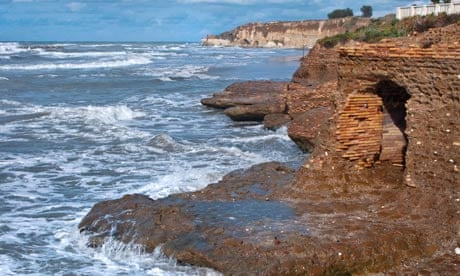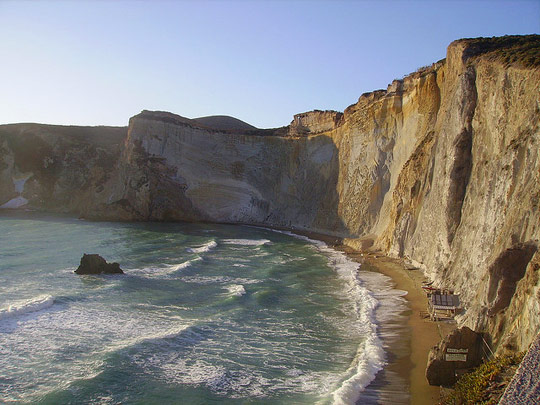Anzio tourist information

Anzio is a medium-sized fishing port on the coast of Lazio, south of Rome. It was an important Roman port, but now is best-known for its military significance as a landing-spot for the Allies in
the Second World War.
Things to see in Anzio
Anzio was a Volscian town, and the base for Coriolanus's rebellion against Rome. Later the seaside town, called Antium, became a favourite with the emperors, who built luxurious villas and a
theatre here. Nero was born in the town and the ruins of his villa can be seen along the low cliffs. In January 1944 British and US forces made a landing on the beaches of Anzio, in the assault
that was to liberate Rome from German occupation.
Anzio took a battering during the war, and much of the town has been rebuilt since, although with the same ageing fishing-town atmosphere. The port is busy and colourful, with a view to the east
of the tall buildings of Nettuno and sand dunes beyond. Trees on the slopes above town shelter large and elegant Liberty-style villas constructed for the spiritual heirs of the Roman emperors who
came to holiday here.
There are plenty of restaurants lining the port - many Romans drive to the town simply to enjoy the fresh seafood. It can be tricky finding anything else to eat, however.

To the west, turning your back on the port, a stretch of manicured beach concessions (stabilimenti) leads up to a headland where there is a small park with trees and stone benches. Some
ruins of the Roman port can be seen on the rocks below. A staircase leading down from here, in front of a restaurant, leads to a much more interesting beach (you need to cross over another
stabilimento to reach the 'free' stretch of sand). This sandy stretch is edged by low, unstable-looking cliffs, topped with the ruins of the Roman imperial palace. Remains of Roman walls
and openings dot the bottom of the cliffs, treated with disregard by beach-users (we saw a tramp curled up in one tunnel, lovers entwined in a cave entrance, and boys using another as a makeshift
urinal). At the far end of the beach is a rocky promontory where Roman walls crumble down into the sea, pierced by two intriguing caves. An archaeological park on top of the cliffs allows you to
explore the ruins more closely, but it has very limited opening hours.
Anzio Tourist Information office is located in the town's main square, Piazza Pia. The friendly staff can give you a good map and bilingual guide to the town, but the office is closed for several
hours (1pm-4pm) at lunchtime. To reach Piazza Pia from the railway station, cross the road and descend Via Paolini. The turning to the museums (see below) is on your left. Continue downhill, then
turn right onto Via Fabbri and you'll emerge on Piazza Pia.
Both the Anzio Beachhead Museum (Museo dello Sbarco di Anzio) and the Archaeological Museum are located in the grand 17th-century Villa Adele, on Via di
Villa Adele, just downhill from the railway station. The Anzio Beachhead Museum is run by a non-profitmaking organisation to commemorate the soldiers of all nationalities who took part in the
landings and ensuing battles.
The Roman amphitheatre (Teatro Romano) is situated on the other side of the railway line, up Via Enea, on Piazzale del Teatro Romano. Another place of interest further from the town is
the Tor Caldara nature reserve, an enclave of preserved woodland and sulphur springs which is run by the WWF.
Anzio travel and transport
Anzio is easier to get to by public transport than southern Lazio's other coastal towns. Trains from Rome run directly to the town (and on to Nettuno) at hourly intervals through the day. The
journey takes an hour on the slow double-decker train, and is very cheap (about €3,60 each way). If the ticket office at Anzio is closed, you can buy tickets from the newsagents next door.
Anzio's station (a modernist design) is fairly central; the centre of town and the port are a 10-minute walk downhill.
If your priority is to visit the British Cemetery (Cimitero Inglese), the nearest station to walk from is little Villa Claudia, a couple of stops before Anzio (after Lavinio). However,
taxis are likely to be more obtainable in Anzio itself.
Ferries and hydrofoils run from Anzio to the island of Ponza. Check timetables in advance, as services are infrequent, particularly out
of season.
Historical Information
On 3rd of Sept. 1943 the Allies invaded the Italian mainland, the invasion coinciding with an armistice made with the Italians who then re-entered the war on the Allied side.
Progress through southern Italy was rapid despite stiff resistance, but by the end of October, the Allies were facing the German winter defensive position, which stretched from the river
Garigliano in the west to the Sangro in the east. Initial attempts to breach the western end of the line were unsuccess- ful. Operations in January '44 landed troops behind the German lines, but
defences were well organised, and a breakthrough was not actually achieved until May.
The site of the cemetery originally lay close to a casualty clearing station. Burials were made direct from the battlefield after the landings at Anzio and later, after the Army had moved
forward, many graves were brought in from the surrounding country.
Beach Head War Cemetery contains 2,316 Commonwealth burials of the Second World War, 295 of them unidentified.
There is also one 1stWorld War burial which was brought into the cemetery from Chiete Communal Cemetery near Rome.
 B&B MARECHIARO
in ANZIO / ROM
B&B MARECHIARO
in ANZIO / ROM






